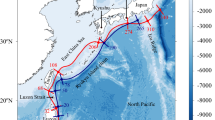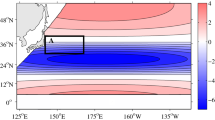Abstract
Assimilation and prediction experiments of the Kuroshio path variability south of Japan were conducted to investigate the predictability of the Kuroshio path. The assimilation and prediction system is composed of an eddy-resolving model and a three-dimensional variational analysis scheme with vertical coupled temperature–salinity empirical orthogonal function modes. The sea surface height (SSH) variability and the variations of the Kuroshio path of the assimilation fields are in good agreement with those observed. The results of the assimilation are then used as the initial conditions for 138 cases of 90-day prediction experiments conducted from 1993 to 2004. The predictive limit of our system is assessed by the SSH anomaly in the assimilation field and is found to be around 40–60 days, which is much longer than that of the persistence. The prediction results show good performance in the transition stage from a straight to a meandering path. For example, a large meandering event that occurred in August 2004 is successfully predicted in a 2-month forecast. Two types of failure cases are investigated. One is a case where the eastward propagation speed of the meander is faster than a real state. The dynamical response of the model to the assimilation revealed that an initial shock, caused by the dynamically unbalanced initial condition, induces the fast eastward propagation of the meander. The other case exhibits an unrealistic meander. In this case, a cold anomaly at an intermediate layer in the initial condition grows rapidly and results in the unrealistic meander. This implies that the Kuroshio path south of Japan has a chaotic nature. These facts revealed by the failure cases give us some insight for improving the predictive skill of the Kuroshio path variability.
Similar content being viewed by others
References
Akitomo K, Masuda S, Awaji T (1997) Kuroshio path variation south of Japan: stability of the paths in a multiple equilibrium regime. J Oceanogr 53:129–142
Ambe D, Imawaki S, Uchida H, Ichikawa K (2004) Estimating the Kuroshio axis south of Japan using combination of satellite altimetry and drifting buoys. J Oceanogr 60:375–382
Arakawa A (1966) Computational design for long-term numerical integration of the equations of fluid motion: two-dimensional incompressible flow. Part I. J Comput Phys 1:119–143
Bloom SC, Takacs LL, Da Silva AM, Ledvina D (1996) Data assimilation using incremental analysis updates. Mon Weather Rev 124:1256–1271
Brasseur P, Blayo E, Verron J (1996) Predictability experiments in the North Atlantic Ocean: outcome of a quasi-geostrophic model with assimilation of TOPEX/POSEIDON altimeter data. J Geophys Res 101:14161–14174
Collecte, Localisation, Satellites (CLS) (2004) SSALTO/DUACS user handbook: (M)SLA and (M)ADT near-real time and delayed time products. CLS-DOS-NT-04.103, Toulouse, p 42
Ebuchi N, Hanawa K (2001) Trajectory of mesoscale eddies in the Kuroshio recirculation region. J Oceanogr 57:471–480
Ebuchi N, Hanawa K (2003) Influence of mesoscale eddies on variations of the Kuroshio path south of Japan. J Oceanogr 59:25–36
Endoh T, Hibiya T (2000) Numerical study of the generation and propagation of trigger meanders of the Kuroshio south of Japan. J Oceanogr 56:409–418
Endoh T, Hibiya T (2001) Numerical simulation of the transient response of the Kuroshio leading to the large meander formation south of Japan. J Geophys Res 106:26833–26850
Fujii Y (2005) Preconditioned optimizing utility for large-dimensional analyses (POpULar). J Oceanogr 61:167–181
Fujii Y, Kamachi M (2003a) Three-dimensional analysis of temperature and salinity in the equatorial Pacific using a variational method with vertical coupled temperature–salinity EOF modes. J Geophys Res 108(C9):3297 DOI:10.1029/2002JC001745
Fujii Y, Kamachi M (2003b) A reconstruction of observed profiles in the sea east of Japan using vertical coupled temperature–salinity EOF modes. J Oceanogr 59:173–186
Fujii Y, Kamachi M (2003c) A nonlinear preconditioned quasi-Newton method without inversion of a first-guess covariance matrix in variational analysis. Tellus 55A:450–454
Fujii Y, Ishizaki S, Kamachi M (2005) Application of nonlinear constraints in a three-dimensional variational ocean analysis. J Oceanogr 61:655–662
Fukumori I (2002) A partitioned Kalman filter and smoother. Mon Weather Rev 130:1370–1383
Griffies SM, Hallberg RW (2000) Biharmonic friction with a Smagrinsky-like viscosity for use in large-scale eddy-permitting ocean models. Mon Weather Rev 128:2935–2946
Hamilton D (1994) GTSPP builds an ocean temperature–salinity database. Earth Syst Monit 4(4):4–5
Holland WR, Chow JC, Bryan FO (1998) Application of a third-order upwind scheme in the NCAR ocean model. J Climate 11:1487–1493
Hunke EC, Ducowicz JK (2002) The elastic–viscous–plastic model for sea ice dynamics. Mon Weather Rev 130:1848–1865
Hurlburt HE, Wallcraft AJ, Schmitz WJ, Hogan PJ, Metzger EJ (1996) Dynamics of the Kuroshio/Oyashio current system using eddy-resolving models of the North Pacific Ocean. J Geophys Res 101:941–976
Hurlburt HE, Smedstat OM, Rhodes RC, Cayula J-F, Barron CN, Metger EJ (2000) A feasibility demonstration of ocean model eddy-resolving nowcast/forecast skill using satellite altimeter data. NRL MR 7320-00-8235, Naval Research Laboratory, Stennis Space Center, Hancock, p 23
Imawaki S, Gotoh M, Yoritaka H, Yoshioka N, Misumi A (1996) Detecting fluctuations of the Kuroshio axis south of Japan using TOPEX/POSEIDON altimeter data. J Oceanogr 52:69–92
Ishikawa I, Tsujino H, Hirabara M, Nakano H, Yasuda T, Ishizaki H (2005) Meteorological Research Institute Community Ocean Model (MRI.COM) manual. Technical reports of the Meteorological Research Institute, No.47. Meteorological Research Institute, Ibaraki (in Japanese)
Ishizaki H, Motoi T (1999) Reevaluation of the Takano–Oonishi schemes for momentum advection on bottom relief in ocean models. J Atmos Ocean Technol 16:1994–2010
Kamachi M, Kuragano T, Sugimoto S, Yoshita K, Sakurai T, Nakano T, Usui N, Uboldi F (2004) Short-range prediction experiments with operational data assimilation system for the Kuroshio south of Japan. J Oceanogr 60:269–282
Kanamitsu M, Ebisuzaki W, Woollen J, Yang S-K, Hnilo JJ, Fiorino M, Potter GL (2002) NCEP-DOE AMIP-II reanalysis(R-2). Bull Am Meteorol Soc 83:1631–1643
Kawabe M (1985) Sea level variations at the Izu Islands and typical stable paths of the Kuroshio. J Oceanogr Soc Japan 41:307–326
Kawabe M (1987) Spectral properties of sea level and time scale of Kuroshio path variations. J Oceanogr Soc Japan 43:111–123
Kawabe M (1995) Variations of current path, velocity, and volume transport of the Kuroshio in relation with the large meander. J Phys Oceanogr 25:3103–3117
Killworth PD, Stainforth D, Webb DJ, Paterson SM (1991) The development of a free-surface Bryan–Cox–Semtner ocean model. J Phys Oceanogr 21:1333–1348
Komori N, Awaji T, Ishikawa Y, Kuragano T (2003) Short-range forecast experiments of the Kuroshio path variabilities south of Japan using TOPEX/Poseidon altimetric data. J Geophys Res 108(C1):3010 DOI:10.1029/2001JC001282
Kondo J (1975) Air-sea bulk transfer coefficients in diabatic conditions. Boundary-Layer Meteorol 9:91–112
Kuragano T, Kamachi M (2000) Global statistical space-time scales of oceanic variability estimated from the TOPEX/POSEIDON altimetry data. J Geophys Res 105:955–974
Kuragano T, Kamachi M (2003) Altimeter’s capability of reconstructing realistic eddy fields using space-time optimum interpolatio. J Oceanogr 59:765–781
Masuda A (1982) An interpretation of the bimodal character of the stable Kuroshio path. Deep-Sea Res 29:471–484
Mellor GL, Ezer T (1991) A Gulf Stream model and an altimetry assimilation scheme. J Geophys Res 96:8779–8795
Mellor GL, Kantha L (1989) An ice-ocean coupled model. J Geophys Res 94:10937–10954
Mitsudera H, Waseda T, Yoshikawa Y, Taguchi B (2001) Anticyclonic eddies and Kuroshio meander formation. Geophys Res Lett 28:2025–2028
Miyazawa Y, Guo X, Yamagata T (2004) Roles of mesoscale eddies in the Kuroshio paths. J Phys Oceanogr 34:2203–2222
Molteni F, Palmer TN, Petroliagis T (1996) The ECMWF ensemble prediction system: methodology and validation. Q J R Meteorol Soc 122:73–119
Moore AM, Mariano AJ (1999) The dynamics of error growth and predictability in a model of the gulf stream. Part I: singular vector analysis. J Phys Oceanogr 29:158–176
Noh Y, Kim H-J (1999) Simulations of temperature and turbulence structure of the oceanic boundary layer with the improved near-surface processes. J Geophys Res 104:15621–15634
Ocean Climate Laboratory (1999) World Ocean Atlas 1998 (WOA98) CD-ROM documentation version 1.0. Ocean Climate Laboratory, National Oceanographic Data Center, Silver Spring
Qiu B, Miao W (2000) Kuroshio path variation south of Japan: bimodality as a self-sustained internal oscillation. J Phys Oceanogr 30:2124–2137
Rhodes RC, Hurlburt HE, Wallcraft AJ, Barron CN, Martin PJ, Metzger EJ, Shriver JF, Ko DS, Smedstad OM, Cross SL, Kara AB (2002) Navy real-time global modering systems. Oceanography 15(1):29–43 (special issue—Navy operational models: ten years later)
Robinson AR, Taft BA (1972) A numerical experiment for the path of the Kuroshio. J Mar Res 30:65–101
Sekine A (1990) A numerical experiment on the path dynamics of the Kuroshio with reference to the formation of the large meander path south of Japan. Deep-Sea Res 37:359–380
Smith WHF, Sandwell DT (1997) Global sea floor topography from satellite altimetry and ship depth soundings. Science 277:1956–1962
Spall MA, Holland WR (1991) A nested primitive equation model for oceanic applications. J Phys Oceanogr 21:205–220
Taft BA (1972) Characteristics of the flow of the Kuroshio south of Japan. In: Stommel H, Yoshida K (eds) Kuroshio—its physical aspects. University of Tokyo Press, Tokyo, pp 165–216
Toth Z, Kalnay E (1997) Ensemble forecasting at NCEP and the breeding method. Mon Weather Rev 125:3297–3319
Tsujino H, Usui N, Nakano H (2006) Dynamics of Kuroshio path variations in a high-resolution GCM. J Geophys Res (in revision)
Usui N, Ishizaki S, Fujii Y, Tsujino H, Yasuda T, Kamachi M (2006) Meteorological Research Institute multivariate ocean variational estimation (MOVE) system: some early results. Adv Space Res 37:806–822
Waseda T, Mitsudera H, Taguchi B, Yoshikawa Y (2003) On the eddy–Kuroshio interaction: meander formation process. J Geophys Res 108(C7):3220 DOI:10.1029/2002JC001583
Weatherly GL (1972) A study of the bottom boundary layer of the Florida current. J Phys Oceanogr 2:54–72
Yoon J-H, Yasuda I (1987) Dynamics of the Kuroshio large meander: two-layer model. J Phys Oceanogr 17:66–81
Yoshida S (1964) A note on the variations of the Kuroshio during recent years. Bull Jpn Soc Fish Oceanogr 5:66–69 (in Japanese)
Author information
Authors and Affiliations
Corresponding author
Additional information
Responsible editor: Jacques Verron
Rights and permissions
About this article
Cite this article
Usui, N., Tsujino, H., Fujii, Y. et al. Short-range prediction experiments of the Kuroshio path variabilities south of Japan. Ocean Dynamics 56, 607–623 (2006). https://doi.org/10.1007/s10236-006-0084-z
Received:
Accepted:
Published:
Issue Date:
DOI: https://doi.org/10.1007/s10236-006-0084-z




